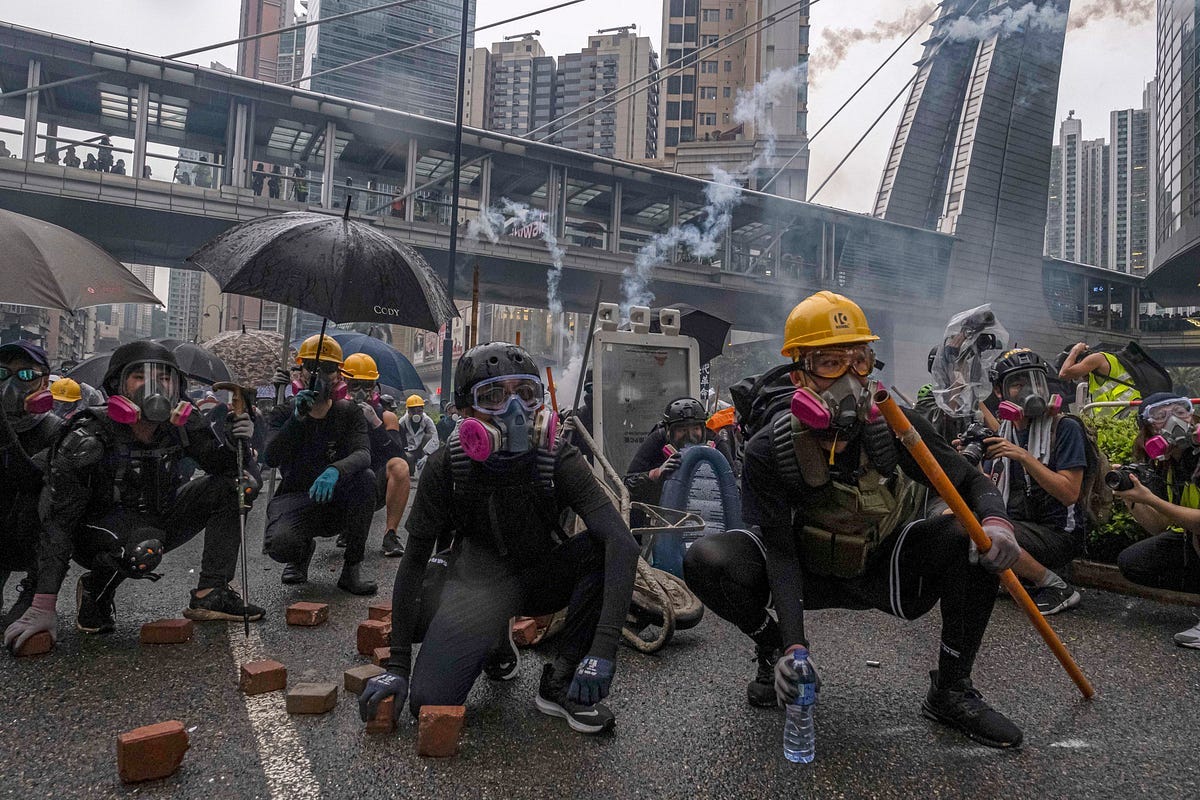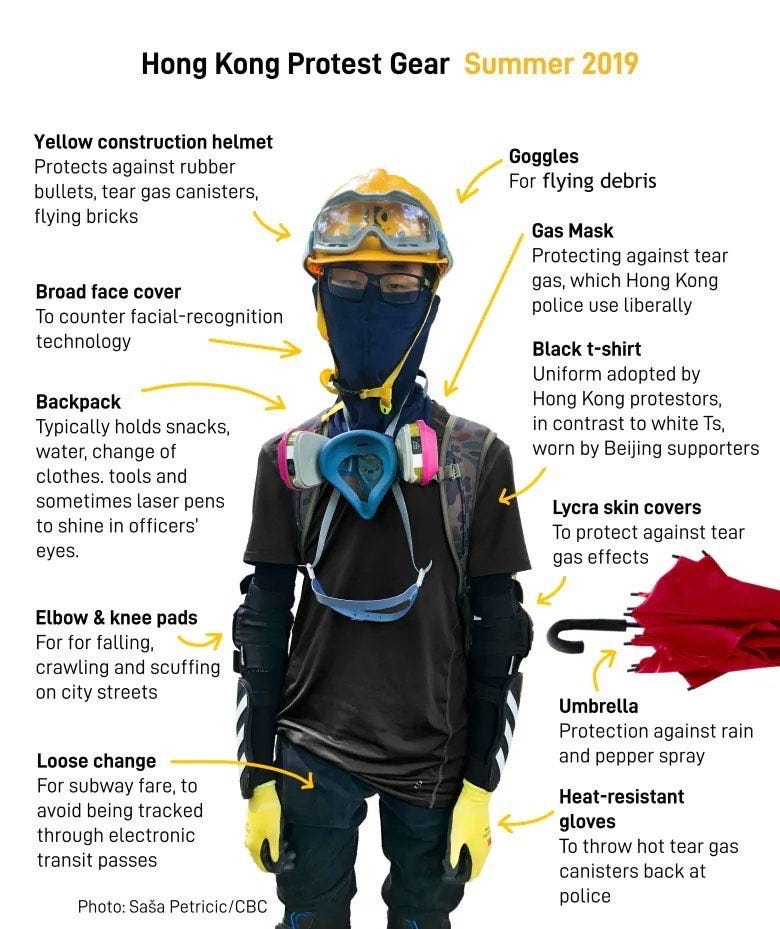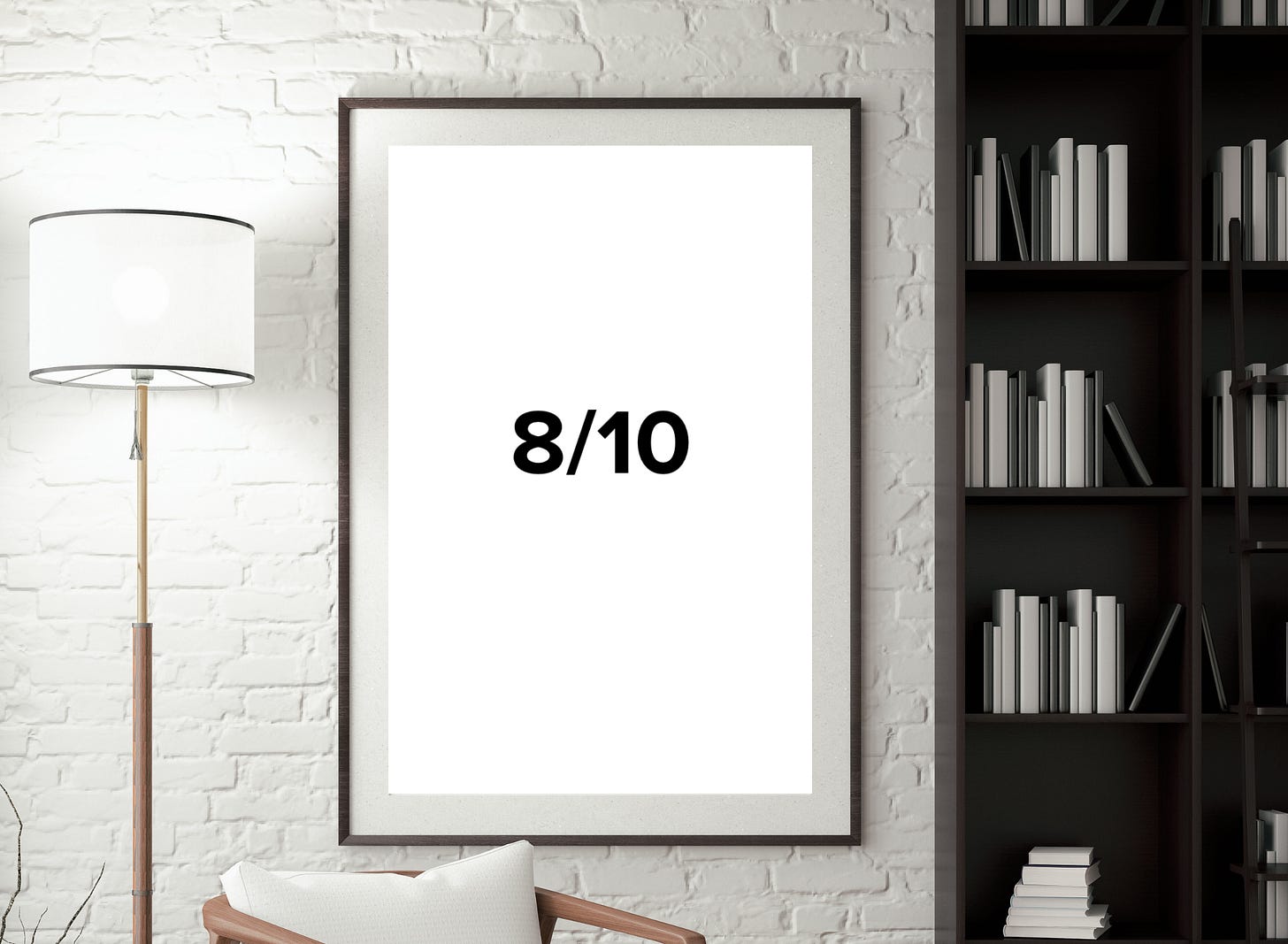8/10 NO BOUNCY CASTLE: HOW AMERICAN PROTEST CULTURE FAILS US ALL
As authoritarianism advances, our comfortable protests ring hollow — but recognizing this weakness is the first step toward building real, transformative resistance.
GAS MASKS. HELMETS. HEAT RESISTANT GLOVES. The acrid smell of pepper spray hanging in humid air. Umbrellas reinforced with aluminum foil to deflect tear gas canisters. Emergency medical supplies stashed in unmarked backpacks. Encrypted messaging apps pinging with real-time police movements.
This was Hong Kong in 2019.
Hong Kong was my home for nearly 13 years. I worked in Central’s glass towers, lived on the outer islands’ quiet shores, breathed this place into my bones until it became part of me. And those 2019 protests hit me in a way I hadn’t felt before. They catalyzed the process of dismantling my comfortable Western expat illusions and forced me to stare directly at truths I’d been privileged enough to ignore . . .
Rights aren’t given.
They’re taken.
And they can be taken back in an instant when power decides they’re inconvenient.
Fast forward to now, and I am in the United States. A place where we are facing the multitude of things that power — wouldn’t you know — has decided is inconvenient.
And what are we doing about it?
Well, let’s talk about last weekend’s HandsOff protest where, having seen so many photos, I can’t help but think the most strenuous activity for many seemed to be deciding between Mimosas or Bloody Marys at their post-activism brunch.
Despite my sarcasm here (oh hey, coping mechanism) I’m not here to criticize people who showed up. Getting off your couch is step one. And I appreciate — or at least hope — that most people believe they were there for the right reason.
Yet the reality remains: That kind of “protest” is not actually helping anyone. Not feeding anyone. Not housing anyone. Not ending state violence. Not stopping deportations, or bombs, or anti-trans-legislation. In fact, to my mind, it’s actually detrimental to our progress.
The U.S. protest scene has become another branch of the entertainment industry. A weekend activity with photo ops and merch. Clever signs that get more attention for their witty puns than their demands.
Y’ALL. We need a fucking reality check.
This kind of protest is never going to push the needle. In Hong Kong, I witnessed young protesters come prepared for the worst case scenario, not Instagram. They used hand signals when speaking would reveal their positions. They left fake transit cards to help fellow protesters escape. They formed human chains to pass supplies across police barricades. They used lasers to disable facial recognition cameras.
They understood what they were up against: An authoritarian regime with decades of experience in making dissidents disappear.
Just.
Like.
Ours.
Now, to be clear: I’m not suggesting everyone should adopt these exact tactics and start communicating with hand signals (though I can think of a couple of hand signals I find particularly effective). Different contexts and different times require different approaches. Yet, what struck me most about the Hong Kong protests wasn’t the way people protested necessarily, but the strategic clarity and commitment. The clear understanding of exactly what we were facing and what meaningful resistance required in that context.
This is the mentality we need to bring to our own context — not through identical methods, but through sustained, community-focused resistance that actually addresses people’s material needs. Creating the world we need, not the world we have.
Hong Kong wasn’t playing revolutionary for socials. Many of the protesters were still in high school, risking everything — their freedom, their futures, their lives — because they understood something fundamental . . .
When fascism comes, it doesn’t announce itself with a parade. It creeps in through laws, through elections, through *reasonable* compromises from *good politicians*. And by the time most people realize what’s happening, the exits are already blocked.
Remember the summer of 2020? When people across this country faced rubber bullets, tear gas, and mass arrests while protesting police brutality after George Floyd’s murder? Didn’t it seem that for a brief moment, much of America-at-large understood what real resistance looked like? People showed up day after day, risking their safety, their freedom, their jobs. They pushed back against militarized police forces while demanding fundamental change. That movement faced brutal repression precisely BECAUSE it posed a legitimate threat to power. That’s what happens when protests actually matter.
Now remember the campus encampments across the U.S. this past year. Students set up tents and occupied spaces to protest their universities’ investments in companies disgusting enough to profit from the genocide in Gaza. They didn’t just show up for a nice little afternoon with their Insta passwords — they built communities of resistance that lasted weeks upon weeks. And it was incredible. They anticipated the pepper spray, the riot police, the arrests. They created radical systems of mutual care and protection while staring down the full weight of state violence.
And what happened? They were labeled as extremists by the same media outlets that fawn over “democracy” protests in other countries. Called antisemitic for opposing the slaughter of Palestinian civilians. All while their supposedly progressive elders tut-tutted about their *tone* and *methods* — as if freedom was ever won by asking politely.
Something all these protests had in common is that none of them ultimately succeeded in their goals. Hong Kong’s autonomy was tragically crushed. Police brutality against Black people continues unabated in America. And Gaza is still being massacred before our eyes.
Yet ask yourself this: If each of these protests had been supported by many more people truly understanding the stakes and building broader, more sustainable approaches to resistance, would we be better off today? If comfortable people everywhere had recognized that meaningful change requires both visible solidarity AND sustained work that addresses people’s material needs, would we all be safer now?
The problem isn’t that protest doesn’t work. It’s that what most Americans call *protest* isn’t actually protest at all and is rarely connected to the deeper community-building work required for resilient long-term change.
Close your eyes and picture photos from the HandsOff protest this last weekend. What were people carrying? What were they wearing?
Now scroll down to see the vibe of Hong Kong protesters in 2019. . .
>
>
>
>
>
>
>
>
>
>
>
>
Spot the difference?
One protest was sadly theater designed to make participants feel good without threatening power. The other was people who understand exactly what’s at stake and came prepared for the fight of their lives.
One gets Instagram coverage, the other gets tanks.
Again, I’m not saying everyone should go out and buy a gas mask. What I am emphasizing is our urgent need for collective purpose and direction — the kind that fuels sustained, community-centered action addressing people’s actual material needs.
Creating the world we need.
Personally, I’ve come to believe we’re beyond the point where traditional protests make a difference. If marches and signs couldn’t create meaningful change during the so-called “progressive White House” of 2021-2024, they’re certainly not going to move the needle now.
Instead, I’ve just chosen to direct my energy toward different approaches — mutual aid, building community, divesting from as much “big” capitalism as possible, and strategic silence.
But if you want to understand why I’m so frustrated with mainstream protest culture, consider this . . . there is a post that went viral this week that perfect embodies much of what I am talking about. After attending her first protest with HandsOff, a white woman posted on Threads:
No bouncy castle.
8/10.
Like she was reviewing a fucking day spa on Yelp.
I’m not here to pile on this woman specifically — yes this post was fucking absurd, privileged, and so white it could be a Lululemon loyalty card — yet she’s just a symptom, not the cause. And ultimately her post perfectly captures the absolute fuckery of American protest culture. The entitlement. The consumer mentality. The complete disconnect from what’s actually at stake.
We are literally facing fascism in America. Have been for a long time. Not metaphorically. Not eventually. Right fucking now. And people are turning up to “resist” with picnic hampers and expectations of entertainment for the kids.
This isn’t resistance.
It’s cosplay.
It’s capitalism.
It’s white supremacy.
Fascism thrives when opposition is performative rather than effective. When we’re more concerned with the optics of resistance than its impact.
When I read that Thread about the bouncy castle, I wanted to scream until my throat bled. Not at the woman particularly but at the entire culture that has reduced resistance to a form of entertainment. At the insidious notion that fighting for your life, your rights, your future should be fun and comfortable.
It shouldn’t.
It can’t be.
That’s the whole fucking point.
We need to get serious with strategic, sustained, community-based actions that create real alternatives to the systems failing us.
We cannot fight fascism with bouncy castles.
We cannot fight fascism while ignoring state violence.
We cannot fight fascism by staying quiet on genocides.
We cannot fight fascism by ignoring children mining in the Congo.
We cannot fight fascism while our tax dollars are bombing children.
We cannot fight fascism by voting once every four years and calling it a day.
And we cannot fight fascism without accepting the United States is built on stolen land with stolen labor.
But we can fight fascism with mutual aid.
We can fight fascism by offering our homes to those in need.
We can fight fascism with boycotts that hurt our convenience.
We can fight fascism by quietly growing food in community gardens.
We can fight fascism with strikes that bring industries to their knees.
We can fight fascism by supporting Land Back with money and resources.
We can fight fascism by creating systems of care that operate outside state control.
We can fight fascism by recognizing that real resistance isn’t always loud and visible.
We can fight fascism accepting discomfort as a necessary part of meaningful change.
We can fight fascism by creating alternatives to the systems we oppose rather than just shouting at them at a protest.
And we can fight fascism by creating the world we need.
If we don’t understand the *actual assignment* and still think about resistance as nothing more than casting ballots every few years, or a weekend activity that should accommodate bouncy castles and Instagram photoshoots, then we’re missing our chance to build the resilient communities and radical solidarity that might actually save us when systems fail.
And that’s not on the fascists, folks. That will be on us.
Want to read and do more?









For me, the protest was a starting point - to realize how many of us there actually are, and then to go home and *do something*. It was inspiring to see how many millions of people have at least some knowledge of the problems we face, but also distressing to realize how many of them would simply go home afterwards and think that they had “done enough”. I think this huge protest was good - to motivate us all, to show us that we’re not alone. However I do agree with you, that more peaceful protests are not going to create the change that we desperately need.
I came to my Hands Off "protest" in St. Paul, MN prepared with anonymous clothes and mask. With safety goggles and a ballistic vest beneath my featureless hoodie.
The response I got was from a woman who told me that I looked like a "bad man."
I left after the crowd started to cheer for my Democratic senator who refuses to deny unanimous consent and continues to vote for appointees.
The senator's biggest gripe in her speech was that she had to catch an early flight out of DC to get here on time.